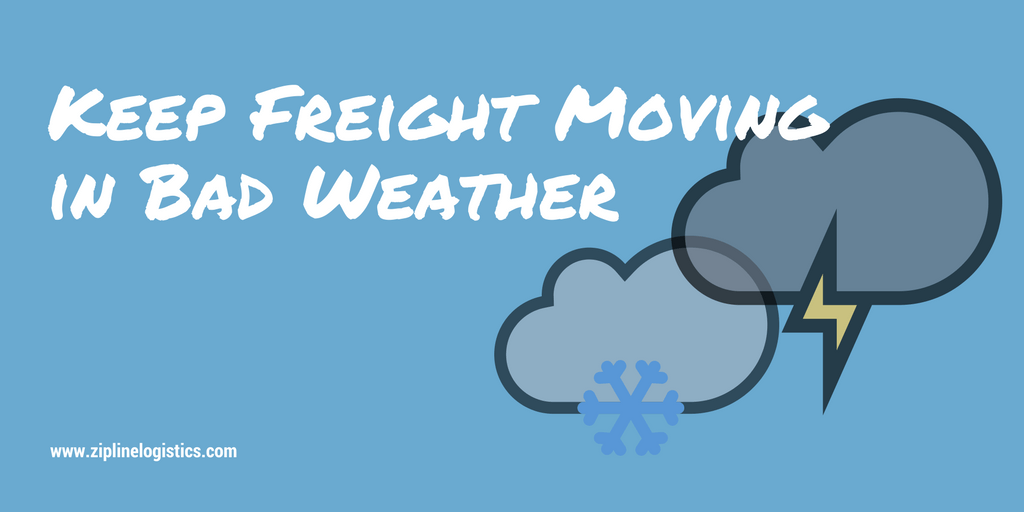Mother Nature can undoubtedly have dramatic impacts on freight transportation. Inclement weather can force shutdowns or transportation delays, and when unheeded, cause severe accidents.
In 2017, transportation has already been impacted by various weather-related challenges.
- February brought soaking storms. Western rail segments and roadways experienced delays and outages from washed-out tracks, landslides, floods, and the need for extensive repairs.
- Earlier in March, wind was a major disruptor. A violent wind storm came through Detroit and knocked out power to over one million utility customers. The same storm derailed a CSX train in Batavia, New York.
- Just last week, snow and wind from Winter Storm Stella shut down traffic and closed ports in the northeast, with most states declaring states of emergency. Snowfall and ice accumulation continued throughout the week, causing major backlogs and congestion.
Weather delays are inevitable. Particularly since more than 70 percent of the nation’s roads are in snowy regions, as reported by the Federal Highway Administration. So, what can shippers, carriers, and third-party logistics (3PL) providers do to prepare and respond?
There’s no benefit to pretending that weather won’t impact pickup and delivery timelines. Instead, having candid, upfront conversations will lead to better outcomes and fewer surprises. Typically, freight can still be moved during bad weather, but often at a higher cost or with an extended timeline.
Increased communication during a storm can make the difference between a smooth shipment and a late or damaged order. As mentioned above, it’s possible to keep freight in motion during a storm, but it takes some extra work.
Solutions for Transportation Delays from Weather
As soon as a storm or weather threat is announced, determine what orders are critical and which have flexibility. 3PL partners can help quickly manage these changes in freight flows because of their access to a network of vetted carriers. Here’s what to keep in mind when making alterations:
- If possible, try to move up transit dates so goods can leave the impacted areas before storms hit. Drivers will appreciate the chance to leave early and avoid potential down-time.
- If unable to move up, determine if you can afford to push back on deliveries. The two- or three-day delay might be worth avoiding the potential dangers and increased transit costs.
- Unable to do any of these options? Vital or time-sensitive shipments can be upgraded and run on a dedicated truck or with a team of drivers to prevent delays due to closures outside your network.
- You could also change modes to secure more capacity. Certain routes could be cleared sooner and switching over from rail to truckload could get shipments where they need to be faster.
- If facing problems with one facility in an afflicted area, you could temporarily ship to or from another in your network.
- When specific lanes are compromised, trucks can be rerouted around problem areas, but be aware that this solution often creates congestion – like a two-lane highway going down to one lane – so there could still be delays.
- Make sure the shipper or consignee where you are delivering is still open. Don’t assume that just because a driver is willing to deliver the load, that the facility hasn’t closed or issued shortened hours.
- Verifying that workers will be present to load and unload can be as important as checking that a facility is open.
- Additionally, ensure their loading and unloading docks are clear and salted for delivery and that potential power loss is accounted for.
- To assist with booking a driver at a reasonable rate, it’s important to see if there are open facilities nearby for him/her to reload and keep moving after delivering your shipment.
Role of 3PL Partner During a Storm
Throughout a period of inclement weather, your 3PL partner should be delivering on an increased level of customer service. Here are a few things you should expect them to be doing:
- Calling receivers on your behalf and sharing information about closures or changes
- Proposing new solutions or contingency plans for shipments
- Providing transparency around shipment status
- Sending regular weather-impact reports or emails
- Checking in regularly with updates
- Using GPS tracking in case of communication gaps
- Aiding drivers with finding backhauls so your shipments are more likely to be covered and at a reasonable rate
Yet even with these proactive responses, sometimes weather still trumps transit plans. States may ban tractor trailers from traveling on highways, a state of emergency may force all vehicles off the road, or downed power lines and trees or car accidents may result in unforeseen congestion.
Your 3PL partner should have an eye on these developments. By talking to carriers, receivers, and other members of their network they can keep you abreast of widespread changes, pivot transportation strategies in response, and provide honest updates on delays.

